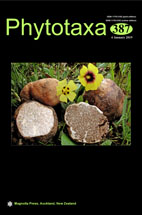Abstract
Sexual morph of Phaeoacremonium aureum was collected from a mangrove in Krabi Province, southern Thailand. It was linked to P. aureum based on the analysis of sequence data. The sexual morph is characterized by ascomata with relatively long conical necks and suballantoid to oblong, slightly curved ascospores, with rounded ends and small guttules at each end. Sexual morph of P. aureum differs from other species of Phaeoacremonium by having ascomata with relatively long (300–380 μm) conical necks and being saprobic on Rhizophora mucronata. This is the first record of Phaeoacremonium species from a mangrove habitat. We also provide a key to sexual morphs of Phaeoacremonium species.

